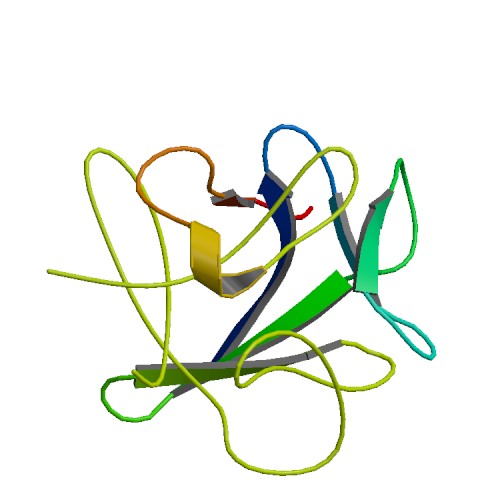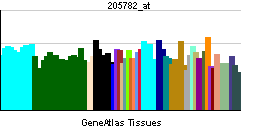FGF7
| Fibroblast growth factor 7 (keratinocyte growth factor) | |||||||||||||
|---|---|---|---|---|---|---|---|---|---|---|---|---|---|
 PDB rendering based on 1qqk. | |||||||||||||
| |||||||||||||
| Identifiers | |||||||||||||
| Symbols | FGF7 ; HBGF-7; KGF | ||||||||||||
| External IDs | Template:OMIM5 Template:MGI HomoloGene: 7316 | ||||||||||||
| |||||||||||||
| RNA expression pattern | |||||||||||||
 | |||||||||||||
| More reference expression data | |||||||||||||
| Orthologs | |||||||||||||
| Template:GNF Ortholog box | |||||||||||||
| Species | Human | Mouse | |||||||||||
| Entrez | n/a | n/a | |||||||||||
| Ensembl | n/a | n/a | |||||||||||
| UniProt | n/a | n/a | |||||||||||
| RefSeq (mRNA) | n/a | n/a | |||||||||||
| RefSeq (protein) | n/a | n/a | |||||||||||
| Location (UCSC) | n/a | n/a | |||||||||||
| PubMed search | n/a | n/a | |||||||||||
Fibroblast growth factor 7 (keratinocyte growth factor), also known as FGF7, is a human gene.[1]
The protein encoded by this gene is a member of the fibroblast growth factor (FGF) family. FGF family members possess broad mitogenic and cell survival activities, and are involved in a variety of biological processes, including embryonic development, cell growth, morphogenesis, tissue repair, tumor growth and invasion. This protein is a potent epithelial cell-specific growth factor, whose mitogenic activity is predominantly exhibited in keratinocytes but not in fibroblasts and endothelial cells. Studies of mouse and rat homologs of this gene implicated roles in morphogenesis of epithelium, reepithelialization of wounds, hair development and early lung organogenesis.[1]
References
Further reading
- Beer HD, Gassmann MG, Munz B; et al. (2001). "Expression and function of keratinocyte growth factor and activin in skin morphogenesis and cutaneous wound repair". J. Investig. Dermatol. Symp. Proc. 5 (1): 34–9. doi:10.1046/j.1087-0024.2000.00009.x. PMID 11147673.
- Ware LB, Matthay MA (2002). "Keratinocyte and hepatocyte growth factors in the lung: roles in lung development, inflammation, and repair". Am. J. Physiol. Lung Cell Mol. Physiol. 282 (5): L924–40. doi:10.1152/ajplung.00439.2001. PMID 11943656.
- Finch PW, Rubin JS (2004). "Keratinocyte growth factor/fibroblast growth factor 7, a homeostatic factor with therapeutic potential for epithelial protection and repair". Adv. Cancer Res. 91: 69–136. doi:10.1016/S0065-230X(04)91003-2. PMID 15327889.
- Ishibashi T, Bottaro DP, Chan A; et al. (1993). "Expression cloning of a human dual-specificity phosphatase". Proc. Natl. Acad. Sci. U.S.A. 89 (24): 12170–4. PMID 1281549.
- Kelley MJ, Pech M, Seuanez HN; et al. (1992). "Emergence of the keratinocyte growth factor multigene family during the great ape radiation". Proc. Natl. Acad. Sci. U.S.A. 89 (19): 9287–91. PMID 1409637.
- Aaronson SA, Bottaro DP, Miki T; et al. (1992). "Keratinocyte growth factor. A fibroblast growth factor family member with unusual target cell specificity". Ann. N. Y. Acad. Sci. 638: 62–77. PMID 1664700.
- Finch PW, Rubin JS, Miki T; et al. (1989). "Human KGF is FGF-related with properties of a paracrine effector of epithelial cell growth". Science. 245 (4919): 752–5. PMID 2475908.
- Rubin JS, Osada H, Finch PW; et al. (1989). "Purification and characterization of a newly identified growth factor specific for epithelial cells". Proc. Natl. Acad. Sci. U.S.A. 86 (3): 802–6. PMID 2915979.
- Ron D, Reich R, Chedid M; et al. (1993). "Fibroblast growth factor receptor 4 is a high affinity receptor for both acidic and basic fibroblast growth factor but not for keratinocyte growth factor". J. Biol. Chem. 268 (8): 5388–94. PMID 7680645.
- Yan G, Fukabori Y, McBride G; et al. (1993). "Exon switching and activation of stromal and embryonic fibroblast growth factor (FGF)-FGF receptor genes in prostate epithelial cells accompany stromal independence and malignancy". Mol. Cell. Biol. 13 (8): 4513–22. PMID 7687739.
- Mattei MG, deLapeyrière O, Bresnick J; et al. (1995). "Mouse Fgf7 (fibroblast growth factor 7) and Fgf8 (fibroblast growth factor 8) genes map to chromosomes 2 and 19 respectively". Mamm. Genome. 6 (3): 196–7. PMID 7749227.
- Werner S, Smola H, Liao X; et al. (1994). "The function of KGF in morphogenesis of epithelium and reepithelialization of wounds". Science. 266 (5186): 819–22. PMID 7973639.
- Wilson SE, Walker JW, Chwang EL, He YG (1993). "Hepatocyte growth factor, keratinocyte growth factor, their receptors, fibroblast growth factor receptor-2, and the cells of the cornea". Invest. Ophthalmol. Vis. Sci. 34 (8): 2544–61. PMID 8392040.
- Guo L, Degenstein L, Fuchs E (1996). "Keratinocyte growth factor is required for hair development but not for wound healing". Genes Dev. 10 (2): 165–75. PMID 8566750.
- Ornitz DM, Xu J, Colvin JS; et al. (1996). "Receptor specificity of the fibroblast growth factor family". J. Biol. Chem. 271 (25): 15292–7. PMID 8663044.
- Post M, Souza P, Liu J; et al. (1996). "Keratinocyte growth factor and its receptor are involved in regulating early lung branching". Development. 122 (10): 3107–15. PMID 8898224.
- Zimonjic DB, Kelley MJ, Rubin JS; et al. (1997). "Fluorescence in situ hybridization analysis of keratinocyte growth factor gene amplification and dispersion in evolution of great apes and humans". Proc. Natl. Acad. Sci. U.S.A. 94 (21): 11461–5. PMID 9326632.
- Winkles JA, Alberts GF, Chedid M; et al. (1997). "Differential expression of the keratinocyte growth factor (KGF) and KGF receptor genes in human vascular smooth muscle cells and arteries". J. Cell. Physiol. 173 (3): 380–6. doi:10.1002/(SICI)1097-4652(199712)173:3<380::AID-JCP10>3.0.CO;2-G. PMID 9369951.
- Ishibashi T, Tanaka T, Nibu K; et al. (1998). "Keratinocyte growth factor and its receptor messenger RNA expression in nasal mucosa and nasal polyps". Ann. Otol. Rhinol. Laryngol. 107 (10 Pt 1): 885–90. PMID 9794620.
- Mongiat M, Taylor K, Otto J; et al. (2000). "The protein core of the proteoglycan perlecan binds specifically to fibroblast growth factor-7". J. Biol. Chem. 275 (10): 7095–100. PMID 10702276.
| This protein-related article is a stub. You can help Wikipedia by expanding it. |